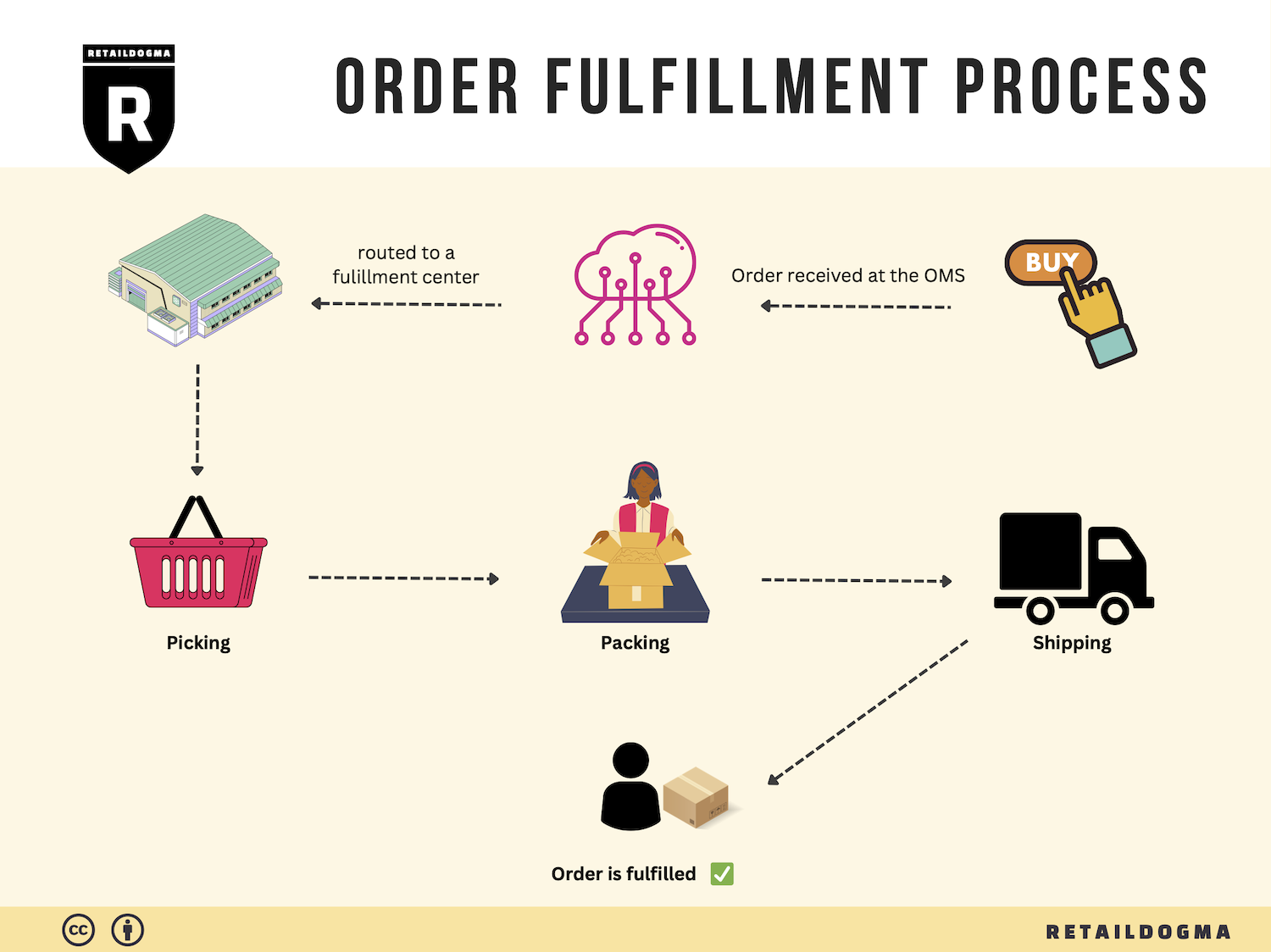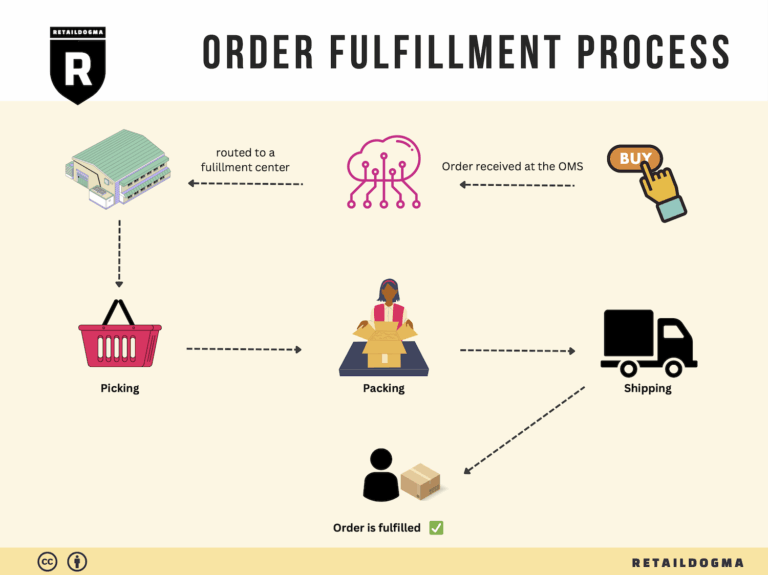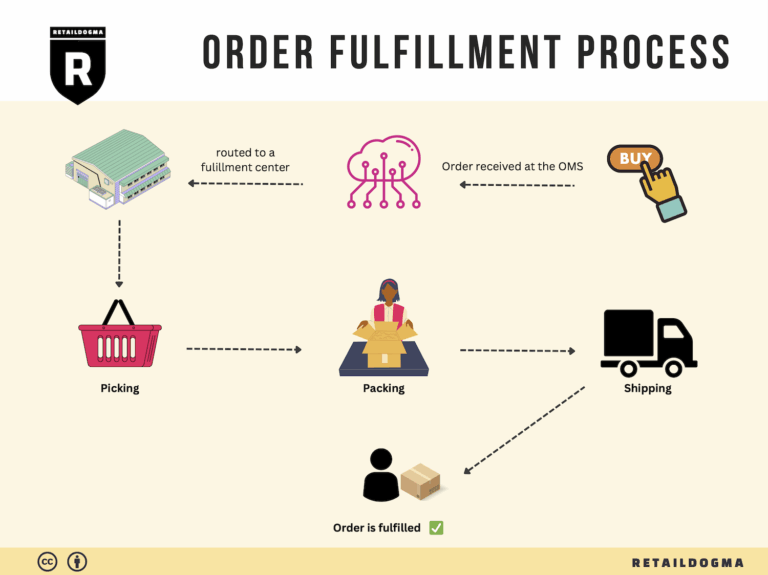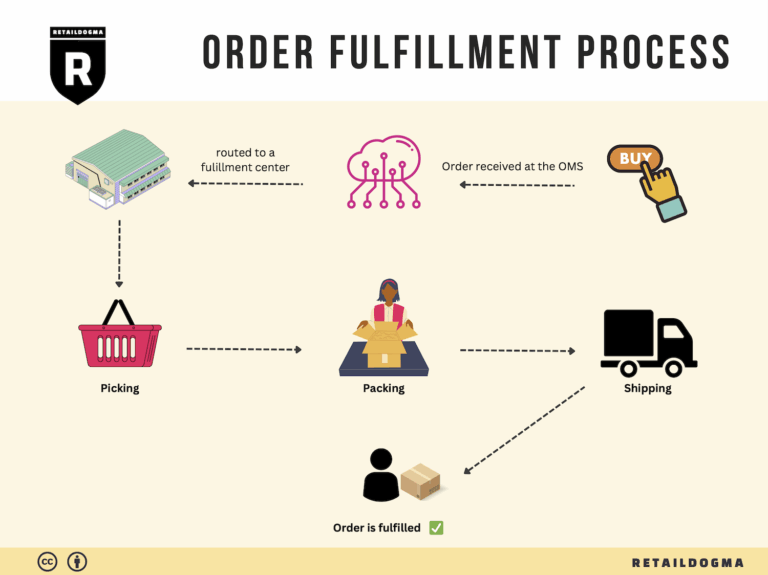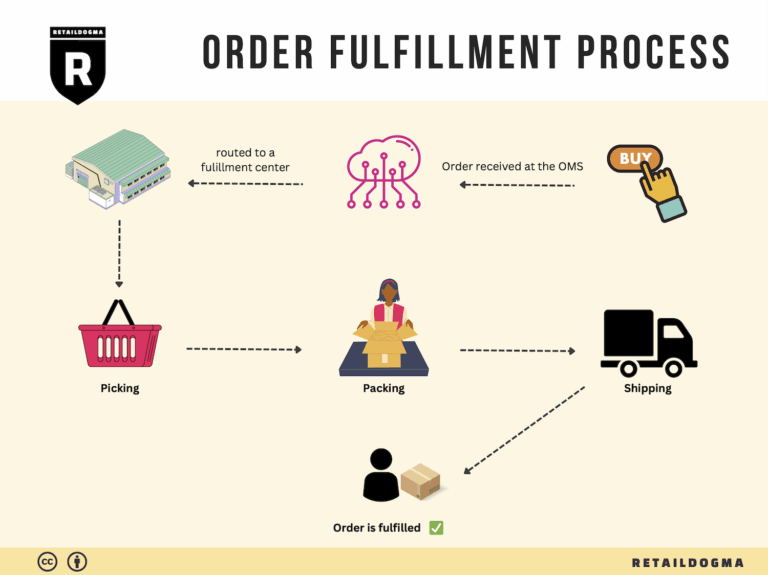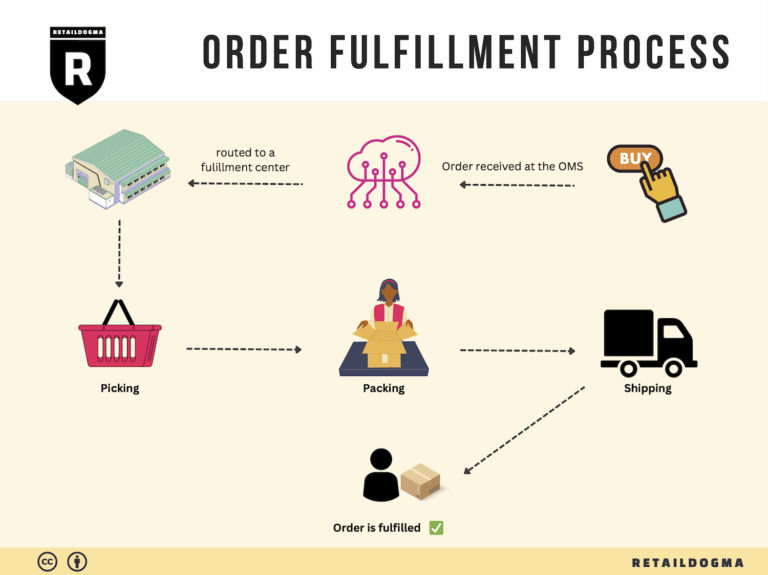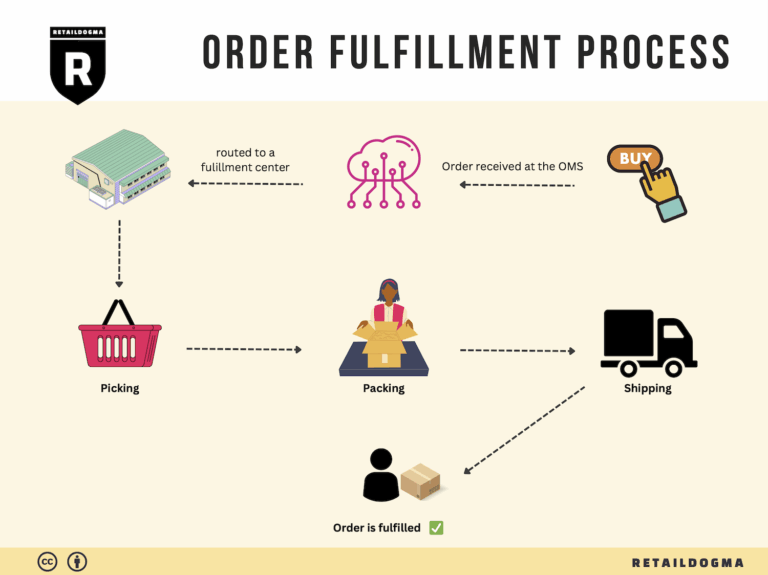What Is A Fulfillment Center? A Complete Guide (2025)
What is E-commerce Fulfillment? An Introduction for Growing Businesses
Understanding the Challenges of E-commerce Fulfillment
As an e-commerce business owner, the thrill of growing sales can quickly turn into an overwhelming burden when faced with the complexities of packing and shipping orders. Managing logistics can become a daunting task, especially as order volumes increase. The process of getting a product to a customer—known as fulfillment—can be the difference between a satisfied customer and a lost sale. It encompasses everything from inventory management to order processing, packing, and shipping.
Defining E-commerce Fulfillment
E-commerce fulfillment is the backbone of any online retail operation. It involves a series of steps designed to ensure that a customer’s order is processed accurately and delivered in a timely manner. This guide will explore various fulfillment models, including third-party logistics (3PL) and Fulfillment by Amazon (FBA), which are popular choices for growing businesses. Each model has its own set of advantages and considerations, making it essential to understand the options available.
Core Services of E-commerce Fulfillment
Fulfillment services typically include inventory storage, order processing, packing, shipping, and returns management. As your business scales, leveraging these core services can help streamline operations and improve efficiency. Understanding how each service works and how they can be integrated into your operations is crucial for maintaining a seamless customer experience.
Choosing the Right Fulfillment Partner
Selecting the right fulfillment partner is a critical decision that can impact your business’s success. Factors to consider include the partner’s location, technology capabilities, scalability, and customer service. This guide will provide insights into how to evaluate potential partners and what questions to ask to ensure they align with your business goals.
Navigating Pricing Structures
Pricing is another vital aspect of e-commerce fulfillment that can significantly affect your bottom line. Understanding the different pricing structures—such as pay-per-order, monthly fees, or volume discounts—will help you assess the total cost of outsourcing your fulfillment needs.
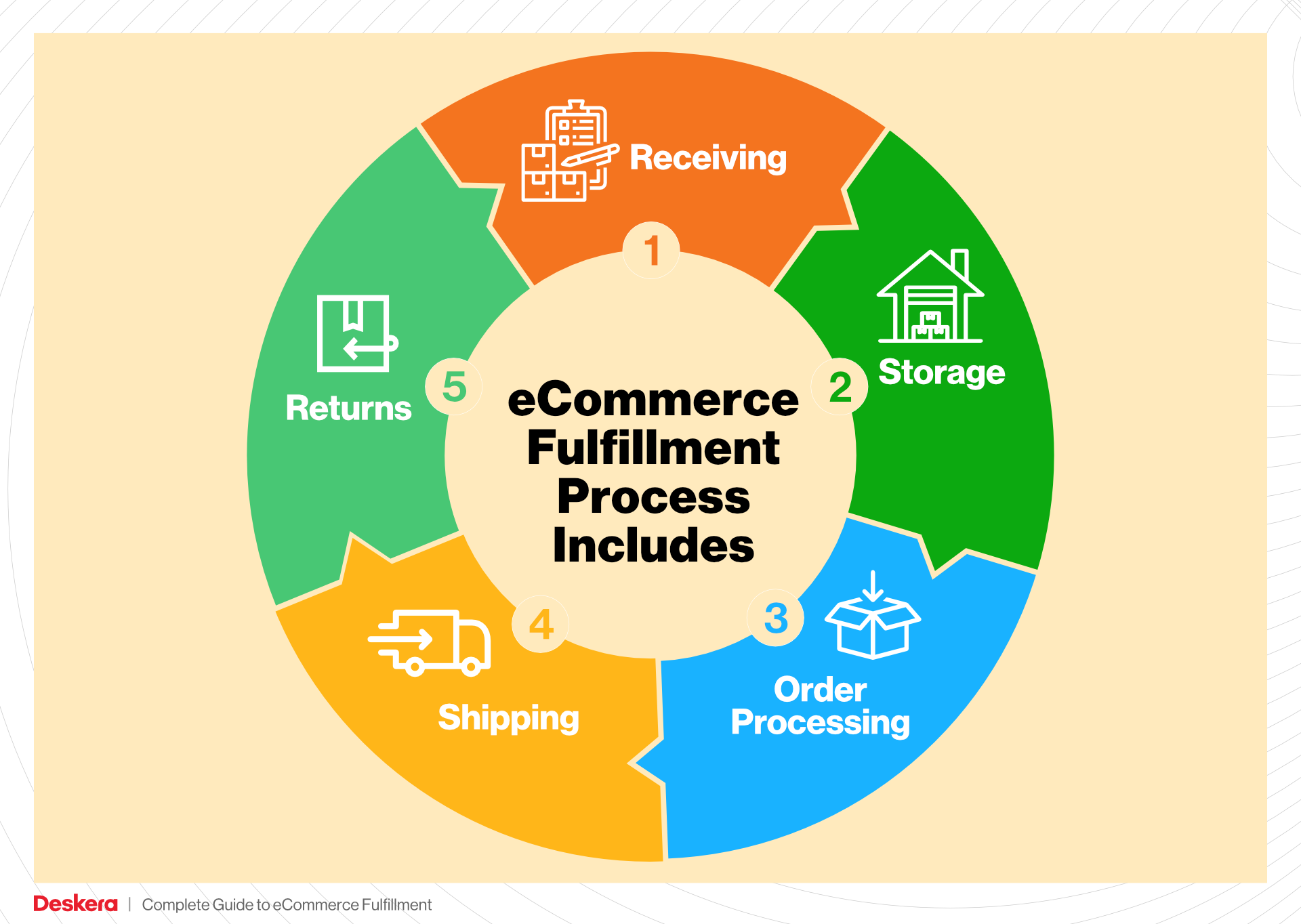
Empowering Your Business Decisions
The ultimate goal of this guide is to empower you with the knowledge needed to make informed decisions about your logistics strategy. By understanding the nuances of e-commerce fulfillment, you can choose the right model, select an ideal partner, and optimize your operations to support sustained growth. In the ever-evolving world of e-commerce, having a solid fulfillment strategy in place is key to delivering on customer expectations and driving your business forward.
What You’ll Learn In This Guide
- What is E-commerce Fulfillment? An Introduction for Growing Businesses
- The Order Fulfillment Process: From ‘Buy’ Button to Customer’s Door
- Comparing Fulfillment Models: In-House vs. 3PL vs. Dropshipping
- A Deep Dive into Amazon FBA: Pros, Cons, and Who It’s For
- Core Services Offered by Fulfillment Centers
- How to Choose a Fulfillment Partner: A 6-Point Checklist
- Understanding Fulfillment Pricing: A Breakdown of Common Fees
- Frequently Asked Questions (FAQs) about Fulfillment
- Conclusion: Is Outsourcing Fulfillment the Right Move for Your Business?
- Important Disclaimer
The Order Fulfillment Process: From ‘Buy’ Button to Customer’s Door
1. Receiving Inventory
The first step in the order fulfillment process is receiving inventory. Upon arrival at the fulfillment center, products are unloaded from delivery trucks and checked against purchase orders. This ensures that the correct items and quantities have been received. A key term associated with this step is SKU (Stock Keeping Unit), which is a unique identifier for each product.
Receiving inventory is crucial because it sets the foundation for the entire fulfillment process. Accurate inventory tracking helps prevent stockouts and overstock situations, ultimately leading to better customer satisfaction and optimized operational costs. Inaccuracies at this stage can ripple through the entire supply chain, leading to delays and potential losses.
2. Warehouse Storage
Once inventory is received and verified, products are stored within the warehouse. This step involves strategically placing items in designated locations to maximize space and efficiency. The layout of the warehouse is designed to facilitate easy access to items, often employing a method known as slotting, where high-demand products are stored in easily accessible areas.
Efficient warehouse storage is essential as it directly impacts the speed and accuracy of order fulfillment. A well-organized storage system allows for quicker retrieval of items, which is critical in meeting customer expectations for fast delivery. Additionally, it aids in inventory management, ensuring that stock levels are maintained and monitored effectively.
3. Order Picking
When a customer places an order, the next step is order picking. This process involves retrieving the items from their storage locations based on the order details. A commonly used tool in this phase is the pick list, which outlines the items and their respective locations within the warehouse.
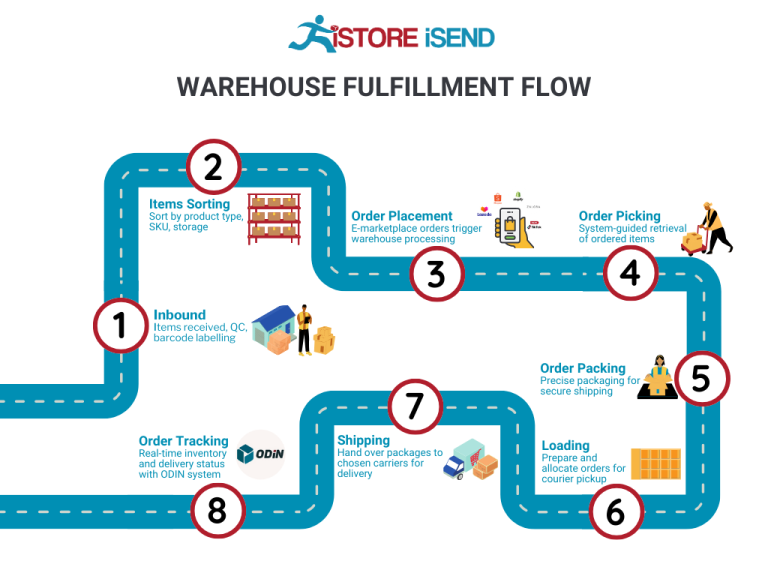
Order picking is a pivotal step in the fulfillment process because it directly influences order accuracy and speed. Errors in picking can lead to customer dissatisfaction and increased return rates. Businesses often employ various picking methods, such as single order picking, batch picking, or wave picking, to enhance efficiency. By optimizing this stage, companies can significantly reduce the time it takes to fulfill orders, thereby improving overall operational efficiency.
4. Order Packing
After items are picked, they move to the packing station, where they are prepared for shipment. This step involves placing the products into appropriate packaging, which may include boxes, padded envelopes, or specialty packaging based on the nature of the items. A critical aspect of packing is ensuring that items are secure and protected during transit, using materials such as bubble wrap or packing peanuts.
Effective order packing is essential for preventing damage during delivery, which can lead to returns and customer dissatisfaction. Additionally, it plays a role in maintaining brand integrity; well-packed orders convey professionalism and care. Packing also involves generating shipping labels and packing slips, which include important information such as tracking numbers and return instructions, further enhancing the customer experience.
5. Shipping & Delivery
The final step in the order fulfillment process is shipping and delivery. Once packages are packed, they are handed over to carriers for transport to the customer. This stage involves selecting the appropriate shipping method based on factors like delivery speed, cost, and destination. A key term here is last-mile delivery, which refers to the final leg of the shipping journey from the distribution center to the customer’s doorstep.
Efficient shipping and delivery are vital for customer satisfaction. Timely deliveries can lead to repeat business and positive reviews, while delays can harm a company’s reputation. Many businesses are now leveraging technology, such as route optimization software and real-time tracking, to enhance their shipping processes. By focusing on this final step, companies can not only meet customer expectations but also create opportunities for upselling and customer engagement post-purchase.
In summary, understanding and optimizing each step of the order fulfillment process—from receiving inventory to shipping and delivery—enables e-commerce businesses to scale effectively. By focusing on accuracy, efficiency, and customer satisfaction throughout the process, companies can enhance their operational capabilities and drive growth in an increasingly competitive market.
Comparing Fulfillment Models: In-House vs. 3PL vs. Dropshipping
Fulfillment Model Comparison
| Model | Who Handles Inventory | Best For (Business Stage) | Key Advantage | Key Disadvantage |
|---|---|---|---|---|
| In-House Fulfillment | The business itself | Startups to established | Complete control over inventory and processes | High overhead costs and resource-intensive |
| Third-Party Logistics (3PL) | A third-party provider | Growing businesses | Scalability and reduced operational burden | Less control over inventory and fulfillment speed |
| Dropshipping | Supplier or manufacturer | Entrepreneurs and startups | Low startup costs and minimal risk | Lower profit margins and reliance on suppliers |
In-House Fulfillment
In-house fulfillment is a model where the e-commerce business manages its own inventory, warehousing, and order processing. This approach is often adopted by startups that wish to maintain complete control over their logistics processes. One of the main advantages of in-house fulfillment is the ability to directly oversee inventory levels, order accuracy, and customer service. Businesses can create a tailored experience for their customers, ensuring that branding and service quality are consistently upheld. However, this model comes with significant drawbacks, including high overhead costs associated with warehousing, staffing, and technology investments. As businesses scale, they may find it challenging to manage increasing order volumes, leading to potential bottlenecks and inefficiencies. Additionally, in-house fulfillment requires substantial time and resource commitment, which can detract from focusing on core business activities like marketing and product development.
Third-Party Logistics (3PL)
Third-party logistics (3PL) providers offer a solution where businesses outsource their inventory management, warehousing, and fulfillment processes to specialized companies. This model is particularly beneficial for growing businesses that need to scale quickly without the burden of managing logistics in-house. By partnering with a 3PL, businesses can leverage the provider’s expertise, technology, and established networks to enhance efficiency and reduce operational risks. A key advantage of 3PL is the ability to scale operations as demand fluctuates, allowing businesses to expand their reach without significant upfront investment in infrastructure. However, relying on a third-party provider means businesses have less control over inventory and fulfillment speed, which can impact customer satisfaction if the 3PL does not meet performance expectations. Additionally, while 3PLs can reduce operational burdens, they may also introduce complexities in communication and coordination, particularly if the provider is not aligned with the business’s goals and standards.
Dropshipping
Dropshipping is a fulfillment model where the retailer does not hold inventory but instead transfers customer orders to a supplier or manufacturer, who then ships the products directly to the customer. This model is ideal for entrepreneurs and startups looking to minimize initial investment and operational risks. One of the primary benefits of dropshipping is the low startup costs; businesses can launch an e-commerce store without the need for significant inventory investment. This model also allows for a wide product range without the associated storage costs. However, dropshipping comes with its own set of challenges. The most significant drawback is the lower profit margins, as suppliers typically charge a premium for handling fulfillment. Additionally, businesses are reliant on suppliers for inventory management and shipping, which can lead to issues with product availability and delivery times. Poor supplier performance can directly affect the retailer’s reputation, making it crucial for businesses to establish strong relationships with reliable suppliers.
A Deep Dive into Amazon FBA: Pros, Cons, and Who It’s For
Understanding Fulfillment by Amazon (FBA)
Fulfillment by Amazon (FBA) is a service that allows e-commerce sellers to store their products in Amazon’s fulfillment centers. When a customer orders a product, Amazon takes care of storage, packaging, and shipping, as well as handling customer service and returns. This service enables sellers to leverage Amazon’s extensive logistics network and customer base, providing a seamless shopping experience for buyers.
How FBA Works
-
Account Setup: To begin using FBA, sellers must create an Amazon seller account and enroll in the FBA program.
-
Inventory Preparation: Sellers prepare their products according to Amazon’s guidelines. This includes labeling and packaging items in a manner that meets Amazon’s requirements.
-
Shipping to Amazon: Once the products are ready, sellers ship their inventory to Amazon fulfillment centers. Sellers can choose from various fulfillment centers, including the one located in Kent, WA, which serves as a crucial hub in the logistics network.
-
Storage and Management: After the inventory arrives at the fulfillment center, Amazon takes over the storage and management of the products. Sellers can monitor their inventory levels through the Amazon seller dashboard.
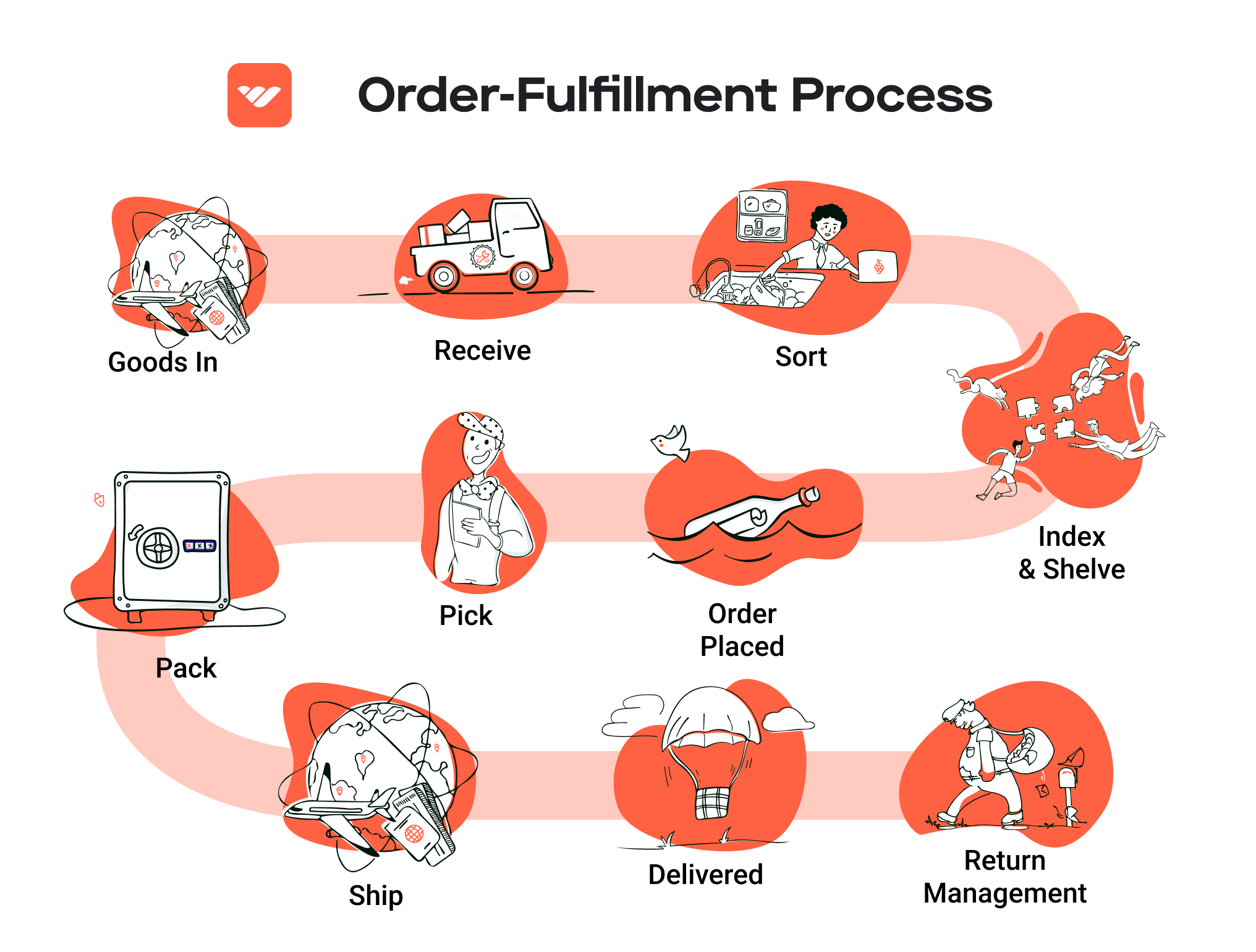
-
Order Fulfillment: When a customer places an order, Amazon picks, packs, and ships the product directly to the customer. This process is facilitated by advanced technology, including robots and conveyor systems, ensuring efficiency and accuracy.
-
Customer Service and Returns: Amazon also handles customer service inquiries related to FBA products, as well as processing returns, allowing sellers to focus on other aspects of their business.
Pros of Fulfillment by Amazon (FBA)
-
Prime Eligibility: Products fulfilled by Amazon automatically qualify for Amazon Prime, which can significantly increase visibility and sales. Prime members often prefer items eligible for fast and free shipping, making FBA a strategic choice for sellers looking to capture this market.
-
Customer Trust: Leveraging Amazon’s brand reputation can enhance customer trust. Buyers are more likely to purchase from sellers using FBA, as they associate the service with reliable delivery and customer service.
-
Multi-Channel Fulfillment: FBA allows sellers to fulfill orders not only from Amazon but also from other sales channels, such as their own website or other marketplaces. This multi-channel fulfillment capability can streamline logistics and improve overall efficiency.
-
Scalability: FBA enables sellers to scale their businesses without the need to invest heavily in logistics infrastructure. Amazon’s fulfillment centers can handle increased order volumes as a business grows.
-
Time Savings: By outsourcing logistics to Amazon, sellers can save time on order fulfillment, allowing them to focus on marketing, product development, and customer engagement.
Cons of Fulfillment by Amazon (FBA)
-
High Fees: FBA comes with various fees, including storage fees for inventory and fulfillment fees for each order. These costs can add up quickly, particularly for sellers with low-margin products. Sellers must carefully calculate their expenses to ensure profitability.
-
Strict Inventory Rules: Amazon has stringent inventory management policies, including requirements for labeling, packaging, and inventory performance metrics. Sellers must adhere to these rules to avoid penalties or account suspension.
-
Commingling Risks: FBA allows for inventory commingling, meaning that sellers’ products may be stored alongside those of other sellers. This can lead to issues if a customer receives the wrong item or if there are quality control problems. Sellers need to consider the risks associated with this practice, particularly for branded items.
-
Limited Control Over Fulfillment: While FBA offers convenience, it also means that sellers relinquish control over the fulfillment process. This can be problematic for sellers who prefer to manage their own logistics or who have specific packaging or shipping requirements.
-
Potential Inventory Restrictions: Amazon may impose limitations on inventory levels for certain categories or products based on demand or performance metrics. This can restrict sellers’ ability to maintain stock levels that match their sales forecasts.
Who is FBA Best For?
Fulfillment by Amazon is particularly beneficial for:
-
Small to Medium-Sized Businesses: Companies looking to scale quickly without the overhead costs of managing their own logistics can find FBA a cost-effective solution.
-
New Sellers: Entrepreneurs just starting out can take advantage of Amazon’s existing customer base and trust, making it easier to gain traction in a competitive marketplace.
-
Sellers of High-Demand Products: Businesses that sell products with proven demand can benefit from the increased visibility and sales potential that comes with FBA’s Prime eligibility.
-
Multi-Channel Sellers: Companies that sell through multiple platforms can streamline their fulfillment processes by using FBA for all their orders.
In conclusion, while Fulfillment by Amazon offers numerous advantages such as increased visibility, customer trust, and scalability, it also comes with challenges like high fees and strict policies. E-commerce business owners must weigh these pros and cons carefully to determine if FBA aligns with their business goals and operational capabilities.
Core Services Offered by Fulfillment Centers
Inventory Management & Warehousing
Inventory management and warehousing are foundational services provided by fulfillment centers, crucial for e-commerce businesses that aim to scale efficiently. Fulfillment centers like Amazon’s in Kent, WA, offer expansive warehouse facilities equipped with advanced inventory tracking systems. These systems utilize barcodes and RFID technology to monitor stock levels in real-time, ensuring that businesses have accurate visibility over their inventory.
The benefits of effective inventory management include:
- Reduced Holding Costs: By optimizing inventory levels, businesses can minimize the costs associated with excess stock, such as storage fees and product obsolescence.
- Improved Order Accuracy: Accurate inventory tracking reduces the likelihood of overselling or stockouts, leading to higher customer satisfaction and trust.
- Scalability: As your business grows, the ability to efficiently manage larger volumes of inventory becomes essential. Fulfillment centers can scale their warehousing capabilities in tandem with your business needs, allowing for flexible growth without the complexities of managing physical storage yourself.
Pick and Pack Services
Pick and pack services are integral to the order fulfillment process. This service involves selecting items from the warehouse (picking) and preparing them for shipment (packing). Fulfillment centers employ sophisticated technology, including automated systems and trained staff, to ensure that orders are picked accurately and efficiently.
The advantages of utilizing pick and pack services are significant:
- Speed and Efficiency: With dedicated staff and technology, fulfillment centers can process orders much faster than an in-house operation, enabling quicker delivery times to customers.
- Error Reduction: Automated picking systems and quality checks significantly lower the risk of shipping errors, which can harm your brand’s reputation and incur additional costs for returns.
- Customization: Many fulfillment centers offer customizable packing options, allowing businesses to enhance their brand image through tailored packaging solutions. This can include branded boxes, special inserts, or gift-wrapping services.
Kitting and Assembly
Kitting and assembly services involve grouping multiple products together to create a single package or kit. This service is particularly valuable for businesses that sell products that are often purchased together or require assembly before use, such as furniture or electronics.
The benefits of kitting and assembly include:
- Enhanced Customer Experience: Offering kits can simplify the shopping experience for customers, making it easier for them to purchase complementary items without having to search for each product individually.
- Cost-Effective Bundling: Businesses can create special offers or bundles that encourage larger purchases, thereby increasing average order value and driving sales.
- Streamlined Operations: By outsourcing kitting and assembly to a fulfillment center, businesses can focus on core activities like marketing and customer service, rather than the labor-intensive process of assembling products in-house.
Returns Management (Reverse Logistics)
Returns management, often referred to as reverse logistics, is a critical service provided by fulfillment centers that can greatly impact customer satisfaction and operational efficiency. This service encompasses the processes involved in handling returned merchandise, from receiving and inspecting items to restocking or disposing of them appropriately.
The benefits of a robust returns management system include:
- Improved Customer Loyalty: A hassle-free return process can enhance customer loyalty and trust. Customers are more likely to purchase from a business that offers easy returns, knowing they have options if the product does not meet their expectations.
- Data Insights: Analyzing return data can provide valuable insights into product performance and customer preferences, helping businesses refine their offerings and reduce return rates over time.
- Cost Savings: Efficient returns management can minimize costs associated with handling returns, such as shipping fees and restocking expenses. Fulfillment centers can often process returns more efficiently than in-house operations, leading to better resource allocation.
In conclusion, the core services offered by fulfillment centers such as Amazon’s facility in Kent, WA, play a pivotal role in the success of e-commerce businesses. By leveraging inventory management, pick and pack services, kitting and assembly, and returns management, businesses can streamline their operations, enhance customer satisfaction, and ultimately scale their sales effectively.
How to Choose a Fulfillment Partner: A 6-Point Checklist
Location & Warehouse Network
Why It Matters:
The geographical location of your fulfillment partner’s warehouses can significantly impact shipping times and costs. A partner with strategically located warehouses can help you reach your customers more efficiently, particularly if you are targeting specific regions.
Questions to Ask:
1. Where are your fulfillment centers located, and how does that affect shipping times to my target customers?
2. Do you have a network of warehouses that can scale with my business needs?
3. How do you manage inventory across multiple locations to ensure availability?
Technology & Integrations
Why It Matters:
In today’s fast-paced e-commerce environment, technology is a key driver of efficiency. A fulfillment partner should offer robust technology solutions that integrate seamlessly with your existing systems (e.g., your e-commerce platform, inventory management software, and customer relationship management tools).
Questions to Ask:
1. What technology do you use to manage inventory and orders?
2. Can your system integrate with my existing e-commerce platform? If so, how?
3. How do you ensure data security and compliance with relevant regulations?
Specializations (e.g., Cold Storage, Oversized Items)
Why It Matters:
Not all products require the same handling. If you sell perishable goods, oversized items, or fragile products, your fulfillment partner should have the necessary capabilities and expertise to manage these special needs effectively.
Questions to Ask:
1. Do you have specialized facilities for handling specific types of products, such as cold storage or oversized items?
2. What protocols do you have in place for managing the unique challenges associated with my product types?
3. Can you provide case studies or references from similar businesses you’ve worked with?
Scalability & Capacity
Why It Matters:
As your business grows, your fulfillment needs will evolve. A good partner should be able to scale their services to accommodate increased order volumes without sacrificing service quality.
Questions to Ask:
1. How do you handle peak seasons and sudden spikes in order volume?
2. What is your capacity for scaling operations, and how quickly can you adapt to my changing needs?
3. Do you have a track record of successfully scaling for other clients? Can you provide examples?
Pricing and Contracts
Why It Matters:
Understanding the pricing structure and contract terms is crucial for budgeting and financial planning. You need to know what costs are associated with different services and how they may change over time.
Questions to Ask:
1. What is your pricing model, and what factors can influence costs (e.g., storage fees, shipping rates)?
2. Are there any hidden fees I should be aware of?
3. What are the terms of the contract, and what is your policy on contract termination or changes?
Customer Support & Reviews
Why It Matters:
Reliable customer support is essential for a successful partnership. You want a fulfillment partner that is responsive and proactive in resolving issues. Additionally, reviews and testimonials can provide insights into the partner’s reliability and service quality.
Questions to Ask:
1. What level of customer support do you offer (e.g., 24/7 availability, dedicated account managers)?
2. Can you provide references or case studies from current or past clients?
3. How do you handle customer complaints or fulfillment errors?
Conclusion
Choosing the right fulfillment partner is a critical decision for your e-commerce business. By using this checklist, you can evaluate potential partners based on their location, technology, specializations, scalability, pricing, and customer support. This structured approach will help you make an informed decision that aligns with your operational needs and growth aspirations, ultimately enhancing your customer satisfaction and overall business success.
Understanding Fulfillment Pricing: A Breakdown of Common Fees
Initial Setup Fees
When partnering with a fulfillment center, the initial setup fees can be a crucial factor in your cost analysis. These fees generally cover the onboarding process, including the integration of your e-commerce platform with the fulfillment center’s systems, inventory setup, and any necessary training for your team on how to manage orders through their platform.
Setup fees can vary significantly depending on the complexity of your operations and the technology used. Typically, these fees range from a few hundred to several thousand dollars. It’s important to discuss your specific needs with the fulfillment provider to understand what is included in the setup process and to ensure that you are not charged for unnecessary services.
Receiving Fees
Receiving fees are charged for the process of accepting and logging your inventory into the fulfillment center. This includes unloading your products from shipping containers, inspecting them for damages, and placing them into storage locations.
These fees are typically calculated on a per-unit or per-pallet basis. For example, a fulfillment center might charge a fixed rate for each pallet received, which may range from $20 to $50, or a per-item fee that could be as low as $0.50 per item. The overall cost will depend on the volume of inventory you send and the complexity of the receiving process. It’s advisable to ask for detailed pricing structures and any potential additional costs related to special handling or inspection requirements.
Storage Fees (per pallet/bin)
Storage fees are incurred for the space your products occupy within the fulfillment center. These fees can be calculated on a monthly basis and are typically charged per pallet or per bin. The cost can vary based on the size and type of the items being stored.
For example, storage fees might range from $10 to $25 per pallet per month, while smaller items stored in bins may incur fees of $2 to $5 per bin per month. Some fulfillment centers may also offer tiered pricing based on the volume of storage utilized, which can help you save costs as your inventory grows. Understanding the layout and storage capacity of the fulfillment center is key to optimizing your storage costs, so be sure to communicate with your provider about your anticipated inventory levels.
Pick & Pack Fees (per item/order)
Pick and pack fees are essential to understand, as they directly affect the cost of fulfilling each order. These fees cover the labor involved in picking the items from storage and packing them for shipment.
Typically, these fees are charged on a per-item or per-order basis. For instance, a fulfillment center might charge $1.00 to $3.00 per item picked, or a flat fee of $5.00 to $15.00 per order, depending on the complexity and size of the items. If your business involves a high volume of small items, it’s crucial to negotiate these fees to ensure they remain manageable as your sales grow. Additionally, inquire about discounts for larger orders or recurring customers, which can help lower your overall costs.
Shipping Fees
Shipping fees are a significant component of fulfillment pricing and can vary based on the carrier, destination, package size, and weight. Fulfillment centers often have partnerships with major carriers, which can lead to discounted shipping rates that they pass on to you.
Shipping fees are typically calculated based on a combination of factors, including the shipping method (standard, expedited, etc.), weight, and dimensions of the package. Be prepared to see a wide range of fees, from $5 for local ground shipping to $20 or more for expedited services. Additionally, some fulfillment centers may charge a handling fee on top of the shipping costs, so it’s important to clarify this with your provider to avoid surprises.
Tips for Getting an Accurate Quote
-
Provide Detailed Information: When requesting a quote, provide specific details about your inventory, including the types of products, expected volume, and any special handling requirements. This will help the fulfillment center give you a more accurate estimate.
-
Ask About Additional Fees: Inquire about any potential hidden fees, such as returns processing, special handling, or seasonal surcharges, which can significantly impact your overall costs.
-
Negotiate Terms: Don’t hesitate to negotiate terms, especially if you anticipate high order volumes. Many fulfillment centers are willing to adjust pricing based on your expected growth.
-
Consider a Trial Period: If possible, negotiate a trial period to evaluate the fulfillment service’s efficiency and costs before committing to a long-term contract.
-
Review Contracts Carefully: Before signing any agreements, review the terms and conditions thoroughly. Pay special attention to any clauses regarding fee increases or changes in service levels.
By understanding these common fulfillment pricing models and following these tips, you can make informed decisions that align with your business growth strategy while keeping costs manageable.
Frequently Asked Questions (FAQs) about Fulfillment
1. What is the Amazon Fulfillment Center in Kent, WA?
The Amazon Fulfillment Center in Kent, WA (BF14) is a large-scale warehouse facility that specializes in order fulfillment and distribution services for a wide range of products. It plays a vital role in Amazon’s logistics operations, ensuring timely and accurate delivery to customers across the country.
2. How does Amazon’s fulfillment process work?
Amazon’s fulfillment process involves receiving products from suppliers, storing them in the fulfillment center, and using advanced technology, including robots and conveyor systems, to pick, pack, and ship orders efficiently. Once an order is placed, the system identifies the product location, and robots transport items to human workers who package them for shipment.
3. What is the difference between a warehouse and a fulfillment center?
A warehouse primarily serves as a storage facility for goods, while a fulfillment center is designed specifically for processing and shipping orders. Fulfillment centers include advanced technology and systems to manage inventory, handle orders, and ensure quick delivery, making them integral to e-commerce operations.
4. What is a 3PL (Third-Party Logistics)?
A Third-Party Logistics (3PL) provider is a company that offers outsourced logistics services, including warehousing, fulfillment, and transportation. Businesses partner with 3PLs to manage their supply chain more efficiently, allowing them to focus on core operations while leveraging the expertise and resources of logistics specialists.
5. How much do fulfillment services cost?
Fulfillment service costs can vary widely based on several factors, including order volume, storage needs, and specific services required (such as packing and shipping). Typically, costs may include a per-order fee, monthly storage fees, and additional charges for special handling or packaging. It’s essential to evaluate multiple providers to find the best fit for your business.
6. Can I visit the Amazon Fulfillment Center in Kent, WA?
Yes, Amazon offers in-person tours of its fulfillment centers, including the one in Kent, WA. These tours provide insights into how the facility operates, showcasing the technology and processes used to fulfill orders. Visitors must register in advance and adhere to safety guidelines, including appropriate attire.
7. What types of products can be stored and fulfilled at the Kent facility?
The Kent fulfillment center handles a diverse range of products, from electronics and household items to clothing and toys. However, certain restricted items, such as hazardous materials or perishables, may not be eligible for storage and fulfillment at this location. It’s advisable to check with Amazon for specific product guidelines.
8. How does Amazon ensure order accuracy and timely delivery?
Amazon employs various technology solutions, such as barcode scanning and automated inventory management systems, to enhance order accuracy. Additionally, the fulfillment center’s strategic location allows for efficient shipping routes, which helps ensure timely delivery to customers across the country.
9. What are the benefits of using Amazon Fulfillment services?
Using Amazon Fulfillment services offers several advantages, including access to Amazon’s vast logistics network, improved order processing speeds, and enhanced customer satisfaction through reliable shipping. Businesses can also benefit from reduced operational overhead and the ability to scale quickly without the need for extensive warehousing infrastructure.
10. What should I consider when choosing a fulfillment partner?
When selecting a fulfillment partner, consider factors such as service scalability, technology integration, pricing structure, and the provider’s experience with your specific product category. Additionally, evaluate the fulfillment center’s geographic location, as this can impact shipping times and costs. It’s crucial to choose a partner that aligns with your business goals and can support your growth.
Conclusion: Is Outsourcing Fulfillment the Right Move for Your Business?
Evaluating the Advantages of Outsourcing Fulfillment
Outsourcing your fulfillment can be a transformative decision for your e-commerce business. The primary benefits include saving time, achieving scalability, and leveraging specialized expertise. By partnering with a fulfillment center, such as those operated by Amazon in Kent, WA, you can delegate the complex logistics of warehousing, inventory management, and shipping. This allows you to focus on core business activities like product development, marketing, and customer engagement, ultimately enhancing your operational efficiency.
Scalability is another critical advantage. As your business grows, so do your order volumes. Fulfillment partners have the infrastructure and technology—like advanced automation and inventory management systems—that can adapt to fluctuating demands without requiring significant investments from your side. This flexibility enables you to ramp up operations during peak seasons without the logistical headaches that can come from managing a larger in-house team.
Moreover, these fulfillment centers offer deep expertise in logistics and customer service. They have refined processes that enhance accuracy and speed, ensuring that your customers receive their orders on time, which is essential for maintaining customer satisfaction and loyalty.
However, it’s crucial to choose the right fulfillment partner that aligns with your business goals. Consider factors such as location, technology capabilities, and service offerings. A thorough evaluation will help ensure that your chosen partner can support your growth trajectory.
Call to Action
Now is the time to assess your current shipping processes. Conduct a comprehensive audit to identify inefficiencies and bottlenecks that could be alleviated by outsourcing fulfillment. By taking this step, you can determine if a fulfillment partner is the right strategic move for your business’s next phase of growth. Don’t miss the opportunity to streamline your operations and enhance your customer experience—start your audit today!
Important Disclaimer
⚠️ Important Disclaimer
The information in this guide is for educational purposes. Fulfillment services, pricing, and platform features change frequently. Always conduct your own due diligence and consult with providers directly before making business decisions.
